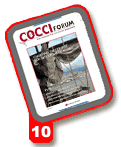COCCI People: Safety NetCoccidiosis vaccination helps Martini Alimentare market birds with confidence and flexibility.
For Dr. Corrado Longoni, choosing the right product for coccidiosis management goes beyond disease control and bird performance. Food safety is his highest priority. “I have two babies at home,” says the poultry veterinarian for Martini Alimentare, Longiano, Italy, a major poultry company located in the northeastern part of the country, about 100 km (62 miles) southeast of Bologna. “When I go down to our company slaughterhouse to buy chicken for my family, I do it with confidence becauseI know our product is safe and free of drug residues. Food safety has to be our first priority — for us, for our customers and for the image of the poultry industry.” It’s hard to argue with Longoni’s
logic, but producing and marketing
residue-free poultry hasn’t always been
easy — especially when using medicated
feeds to control coccidiosis. Thinning out broilers
In Europe, many operations start thinning
out their broiler flocks after 32
days, selling the lighter, less efficient
females at different weights — usually
1.7 to 2.4 kg (3.75 to 5.29 pounds) —
to meet the demand for smaller birds.
They retain the leaner, faster growing,
large-breasted males for chicken parts
and high-volume commercial sale later
in the production cycle.
“Sometimes you need more heavy birds or more lighter birds — it depends on market conditions,” says Giorgio Amedei, live production manager. “That’s why it’s so important for us to remain flexible. “If we used an anticoccidial in the feed, it would mean having two or three withdrawal periods, which would be very difficult to manage. To play it safe, we had to pull the anticoccidial from the feed at 30 days, which is a long time to go without coccidiosis protection.” ‘Can’t take the risk’Feed mill contamination is another concern when using in-feed anticoccidials. Unless the mill’s lines are flushed after each usage — a process that saps extra time and labor — it’s possible for drugs used in one batch to show up in feeds for other birds or other species. “Like other producers, we need to be careful because we do not have a feed mill specifically for broiler feeds,” Longoni explains. “Residues from infeed anticoccidials used in broiler feeds could be toxic to laying hens, breeders or turkeys. We can’t take that risk, nor do we want traces of drugs in our withdrawal feed for broilers.”
Martini was also concerned about
wearing out the few in-feed anticoccidials
that were still on the market. “We have only two chemicals and three
or four ionophores we can use, and we
are not sure how much longer those
products will be available,” Amedei
says. “And without nicarbazin, the
ionophores are also less effective.” Going drug-free
Martini began vaccinating a portion of
its broilers in 2000, when Paracox-5
was approved for use in Europe. The
company was confident it would be a
good product because it had success
with Paracox-8 in breeders. What started as a few experimental
trials gradually spread to entire farms.
As the company obtained more experience
with the product under different
conditions, it extended usage to other
farms. By 2003, Martini was vaccinating all of its broilers with Paracox-5, thus eliminating all in-feed anticoccidials from its program. The antibiotic growth promoter avilomycin is the only medication used today in broilers, but Martini expects to eliminate all drugs as more feed medications are removed from the market. Focusing on management
Between vaccinating for coccidiosis
and getting ready for the expected ban
on all feed medications, Martini is
focusing more on good management
and looking for ways to naturally
improve the immunity of the birds. After Martini stopped using ionophores, there was some concern that necrotic enteritis might become more prevalent, but the company has not seen any significant problems. “We know that ionophores are very
effective against enteritis, but we can’t
use them in our system,” Vandi says.
“Our goal is to manage the problem in
a nutritional way, using a less concentrated
feed in the first phase to cause
less stress on the intestines and have
compensatory growth in the second
period.” “We are also assessing feed distribution,
room temperature and humidity,
ventilation, lighting, type and quality of
litter, and the water supply,” Longoni
reports. |







 © 2000 - 2021. Global Ag MediaNinguna parte de este sitio puede ser reproducida sin previa autorización.
© 2000 - 2021. Global Ag MediaNinguna parte de este sitio puede ser reproducida sin previa autorización.